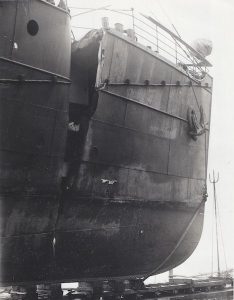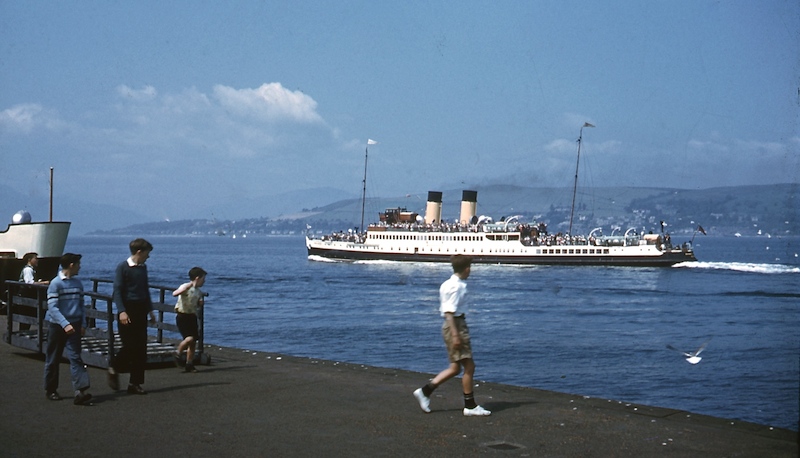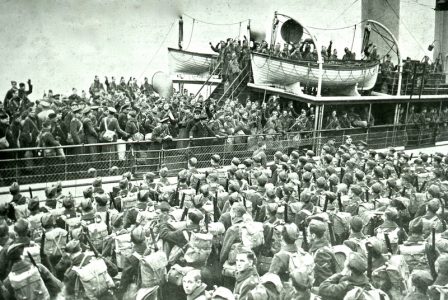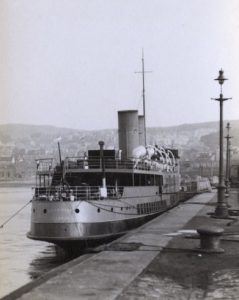 As a teenager in the early 1940s Ian Halliday worked on five Clyde steamers. Now 90, he is one of a dwindling number of people who can remember what it was like to sail on the Firth in wartime — when all ships were painted grey and crews earned ‘danger money’ for working beyond the Cloch-Dunoon defence boom. In this affectionate memoir Ian looks back on a period that, despite the international conflict, yielded unexpected pleasures on the Firth, with camaraderie on board and summer dances ashore offering relief from the prevailing mood of austerity. His account sheds light on a chapter of Clyde steamer history that has hitherto featured remarkably few ‘personal’ accounts of this nature.
As a teenager in the early 1940s Ian Halliday worked on five Clyde steamers. Now 90, he is one of a dwindling number of people who can remember what it was like to sail on the Firth in wartime — when all ships were painted grey and crews earned ‘danger money’ for working beyond the Cloch-Dunoon defence boom. In this affectionate memoir Ian looks back on a period that, despite the international conflict, yielded unexpected pleasures on the Firth, with camaraderie on board and summer dances ashore offering relief from the prevailing mood of austerity. His account sheds light on a chapter of Clyde steamer history that has hitherto featured remarkably few ‘personal’ accounts of this nature.
After the declaration of war in September 1939, the greater part of the Clyde steamer fleet was requisitioned by the Royal Navy and the remainder by the Ministry of War Transport. Most paddlers became minesweepers and were given Royal Navy names, while many of the turbines were allocated specialist roles on the Clyde and other parts of the UK. That left just five ships to provide essential passenger and goods services to the islands and other isolated communities on the Firth. Queen Mary II was on the Dunoon ferry service, Marchioness of Lorne on the Holy Loch run. Duchess of Montrose served Bute, while Marchioness of Graham provided for Cumbrae and Glen Sannox for Arran. I was fortunate enough to serve on all five ships.
Duchess of Argyll and King Edward acted as tenders for big ships at the Tail of the Bank, ferrying troops to and from Gourock and Princes Pier, where they boarded trains heading to camps all over the UK. Duchess of Argyll worked from time to time as ‘spare ship’ when one of the five service ships was withdrawn for annual overhaul or repair.
The colourful livery of the various companies disappeared soon after war was declared, and steamers were painted an uninteresting shade of grey. To meet blackout regulations, the larger windows on each ship were given wooden covers for most of the year. Portholes were painted on the inside to ensure no lights were visible from the water. During summer months the long light evenings allowed the wooden covers to be removed from the main public areas, but the ships did not sail in darkness and the crew were not allowed to use lights in lounges after 11pm.
During the summer holidays in 1940 my school class was asked to help with the war effort and we ended up cutting bracken on the hills above Bellanoch on the Crinan Canal. To find something more satisfying and enjoyable I decided that for future school holidays I would try to obtain a job on the steamers. The problem was that, although I was in my school’s fourth year in 1941, I was still only 15 years of age, and my first approach was rejected on the grounds that I was far too young. I was told to come back when I was at university.
But as June approached I kept visiting the office on Gourock pier and gradually built a relationship with the staff as one of their most persistent visitors. In mid June I received a phone call asking me to come for an interview and, after a very short discussion, I was offered my dream holiday job — that of assistant purser. As a consequence of the war, universities were lengthening their terms, squeezing a four-year degree course into three years by shortening their summer vacation to just six weeks. The traditional source of supply for assistant pursers had vanished overnight. I skipped the last 10 days of the school term, packed my bags and was ready for work the next day.
The pay for an assistant purser in 1941 was £5 per month but, if posted to a ship which sailed outside the Cloch-Dunoon defence boom, you were given an additional £10 per month ‘danger money’. On reporting for duty, assistant pursers had to hand over their civilian ration book to the chief steward, but the ‘sweety’ coupons were handed back. A seaman’s book was much more generous than a civilian’s. Additional clothing coupons were issued on a ‘one-off’ basis to provide for uniform. I bought my uniform and cap at one of the ‘50-bob’ tailors but the gold braid was provided by the office on Gourock pier.
The ‘Lorne’ and the ‘Sannox’

‘Small but well fitted to her route’: Marchioness of Lorne in wartime — copyright photo CRSC Archive Collection
I reported for duty on a Monday morning, having no idea to which run I would be attached. I was introduced to Donald McNaughton, purser of Marchioness of Lorne, and we walked along the pier to the only remaining paddler at Gourock, where I was introduced to the chief steward and given my bunk in a cabin with water rippling across the porthole. I remember it had a damp smell, probably due to the fact that the room had not been in use for some time.
The ‘Lorne’ was small and relatively slow, but seemed well fitted to her route. We sailed from Gourock to Kilcreggan, on to Cove, across the mouth of Loch Long to Blairmore, along the shore to Strone and across the mouth of the Holy Loch to Kirn and Hunter’s Quay, and then on to Kilmun before retracing our steps back to Gourock. This route kept an assistant purser on his toes, because there were no more than a few minutes between piers. We repeated this routine four times a day.
The purser issued tickets and did the cargo manifests. My job as assistant purser was to man the gangway, collect the tickets and between piers cancel them by a hand machine, sorting them in numerical order and tying them up in fifties for return to the office at the end of the day.
We took on coal at Gourock several times a week. This was a dirty job for coal men and crew. The coal, in one-hundred-weight sacks, was carried on over planks and dropped down chutes through circular manholes on the deck to the boiler room below. After coaling the ship had to be hosed down before we moved along the quay to take on passengers and cargo.
Taking on coal or cargo over planks could be a tricky business: much depended on the state of the tide. If the main deck and pier were almost level, it was straightforward. However, at low tide the decline could be steep and the speed of the trolley had to be controlled using ropes. Throwing luggage or cargo on board was easier but took little account of the safety of the contents. It was not unusual for the deck officer on duty to turn a blind eye to this practice.

Glen Sannox passes Holy Isle’s ‘Wee Donald’ Lighthouse in 1945, shortly after the lifting of the boom at the southern entrance to Lamlash Bay — copyright photo CRSC Archive Collection
We tied up overnight at Kilmun — a lovely little spot but with a high midge population. Officers and crew strolled along to the village pub each evening, leaving me behind “to look after” the ship: very boring and not what I had in mind when picturing the life of an assistant purser.
Two weeks later and without warning I was informed that I was being transferred to Glen Sannox. A railway ticket was handed to me as I gathered my kit together, and I made my way to Fairlie via Paisley Gilmour Street.
The ‘Sannox’ made only one return trip to Arran each day, sailing via the north end of Cumbrae and calling at Brodick and Whiting Bay. Lamlash Bay was fenced in by a boom at each end of Holy Isle, forming a specialist harbour for aircraft carriers and other naval ships. Brodick was the main port and we spent some time there unloading the cargo.
What we did not have time to unload on the outward voyage was unloaded on the way back. We tied up at Fairlie overnight and, to my disappointment, the village was even quieter than Kilmun! But I only spent one week on the Arran run which, to me, was more than sufficient. Again without warning, I was informed I was being transferred.
The ‘Montrose’
My next ship was Duchess of Montrose, on the Wemyss Bay-Rothesay run. Wemyss Bay may be only a few miles north of Fairlie, but the only way to get there was via Paisley, where again I changed trains and made my way back down to the coast.

Four months after Ian Halliday left Duchess of Montrose to return to school, the ship was badly damaged in a collision off Greenock with the Royal Fleet Auxiliary tanker Montenol. There were no casualties, but the ‘Montrose’ spent the whole of January 1942 being repaired on Lamont’s Port Glasgow slipway. She then continued in service until her withdrawal in 1964 — unlike the relatively undamaged Montenol, which was torpedoed and sunk off West Africa just five months after her brush with the ‘Montrose’ — CRSC copyright photo
I spent the remainder of the summer on Duchess of Montrose, “the finest ship in the fleet” as Para Handy would say. She was fitted to a very high standard and, despite the war, was still in excellent condition. The engines were extremely quiet: when working in the cancellation room I had to open the door to hear if we were still sailing. There was always a great debate in steamer circles about whether Duchess of Hamilton was faster, but for me the ‘Montrose’ had the better finish. She was “just sublime”.
The dining saloon still operated to pre-war standards. The stewards in white jackets served a widely varying menu – food not generally to be had at home on weekly rations. For some reason it was a much better cuisine than what was served on the ‘Lorne’ and the ‘Sannox’.
The purser, Eddie Baker, taught me a lot and gave me plenty of freedom, which I much enjoyed. Our route was Wemyss Bay to Rothesay with two stops at Innellan each day. As the direct service took 45 minutes my work en route could be completed in a quarter of an hour, leaving me ample time to have the run of the ship. I was welcomed on the bridge and, from time to time, allowed to take the wheel in mid channel. I thought I was performing reasonably well until the captain told me to look astern [revealing a squiggly wake].
On the morning run we carried a lot of cargo — mainly food and milk — with lighter loads later in the day. As a result, the time at the pier was dependent on the quantity of cargo rather than passenger numbers. Wartime passenger capacity was reduced to 1,500, as we were sailing outside the defence boom between the Cloch and Dunoon. However, demand on Glasgow Fair Saturday was so great that we made two runs with more than 2,300 on board each voyage. It was a struggle to reach the ticket office after we cast off.
Tying up at Rothesay each night was a young purser’s dream. The town was teaming with holidaymakers, evacuees (some 3,000 at its peak), sailors from HMS Cyclops (a submarine depot ship moored in Rothesay Bay) and boats from the seventh submarine flotilla — not to mention the local community. There were holiday shows, dances and other community activities – plenty to do, in complete contrast to Kilmun and Fairlie. I had a wonderful summer and it was with reluctance that I returned to school at the end of August.
The ‘Graham’
At Easter 1942 I was offered a second summer as assistant purser and found that I was to be attached to Marchioness of Graham on the Wemyss Bay-Largs-Cumbrae route [berthing at Keppel because of a wartime defence boom across Fairlie Roads]. We made an early run from Keppel to take workers to the mainland and then, after two other runs, finished with an early evening voyage back to the island. The ship was always pleasantly busy with passengers and cargo. Occasionally we carried a vehicle which embarked using planks, but this had to be at a time when the tide was favourable.

‘We left Keppel shortly after noon’: Marchioness of Graham on 18 February 1940 — copyright photo CRSC Archive Collection
The master was the legendary Fergus Murdoch and the purser Bill Gray. Marchioness of Graham was a happy ship and I quickly became one of the family. With her high superstructure and shallow draught, she was difficult to handle in adverse weather, but it was a treat to observe Fergie and his pilot bringing the vessel alongside Largs pier in strong offshore winds.
The ‘Graham’ had a one-off routine for a Sunday. We left Keppel just after noon and sailed to Fairlie, where we picked up our passengers. Most were going to visit family and friends at the temporary wartime hospital in the grounds of Garrison House in Millport, a specialist unit for tuberculosis patients. A return journey to Fairlie was made at about 4.30pm. Much to the master’s surprise, for some four Sundays in July and August our voyage was extended to Rothesay and the Kyles of Bute, turning at Colintraive and then picking up the hospital visitors at Keppel before crossing to Fairlie. We then returned to Keppel without passengers, ready for the Monday morning departure. Apparently this extended sailing to the Kyles was intended as a morale booster for Clydesiders, and to the best of my knowledge it was the only non-essential service during the war.
Unlike Rothesay, Millport had few military personnel: a handful were attached to the hydrophone underwater acoustic listening post at Eerie Port on the north-western shore of the island (known ever since as the Hush-Hush). However, in July and August Cumbrae had its full quota of holidaymakers who enjoyed the shows and dancing. Like Rothesay it was ideal for a young assistant purser.
The ‘Mary’
Early in June 1943 I was asked if I would consider coming back as senior assistant purser on Queen Mary II. The request had a financial consequence: I would lose my £10 per month down-firth danger money, but gain a basic salary of £7 10/- rather than £5. In addition I could live at home with free rail travel to Gourock if I so wished. As the ‘Mary’ tied up every night at Gourock, not such an appealing prospect as Rothesay or Millport, I accepted the offer.
The purser was the experienced Joe Beattie, with Captain Brown in charge — a safe pair of hands I was told, but the antithesis of Fergie Murdoch. When I reported for duty I found there was an assistant purser already on board. Under Joe Beattie’s beady eye he was to be responsible for the passenger activities and I the cargo.
Dunoon was remote by road and consequently most goods arrived across the water from Gourock. The early runs were extremely busy, particularly with household goods, so much so that at times we had to leave loaded trolleys on Gourock pier. This usually happened when the tide was low and the trolleys had to be braked by ropes on their downward journey to the aft deck. This beautiful teak deck was protected by a covering to ensure it was not permanently damaged by trolleys out of control.
As the day wore on the loads became lighter and I could heave a sigh of relief, giving me more time on the short trip to check all the manifests. I cannot recall how many round-trips we made each day, but it was in effect a shuttle service.
My last journey as a member of the crew was made late in August 1943. While I had enjoyed my new responsibilities, I was not as sad to leave Queen Mary II as I would have been if I had finished on Duchess of Montrose or Marchioness of Graham.
Ian Halliday was born in Port Glasgow on 9 January 1926 and has lived in Greenock since 1950. He spent the later years of the Second World War with the Royal Military Engineers and, after being demobbed in December 1947, studied maths and physics at Glasgow University. He later became deputy director of education for Strathclyde Region. Now a great-grandfather, he has continued sailing on the steamers for pleasure, and was a passenger on Queen Mary on her last CalMac sailing in 1977.
With thanks to Douglas Brown
IAN HALLIDAY’S FIVE STEAMERS — IN WAR AND IN PEACE

The ‘Montrose’ as she is best remembered, in her postwar pomp — copyright photo CRSC John Thomas Collection

Marchioness of Lorne leaving Hunter’s Quay towards the end of the war — copyright photo CRSC Archive Collection

Glen Sannox cuts a remarkably elegant profile in wartime grey — copyright photo CRSC Archive Collection

Ian Halliday remembers Queen Mary’s last public sailing in 1977 — copyright CRSC Dr Joe McKendrick Collection
 STEAMERS AT WAR
STEAMERS AT WAR
If you have enjoyed Ian Halliday’s memoir, you may like to read more about the role played by Clyde steamers in the 1939-45 conflict in Steamers at War, a 32-page CRSC publication of outstanding interest to ship enthusiasts and aficionados of naval and military history.
Based on research undertaken by the late Peter Herriot, a former CRSC president, Steamers at War goes into considerable detail about the risky minesweeping activities of Clyde paddlers far from home, without neglecting the more mundane duties of steamers left on the Clyde.
First published in 2015, it includes many previously unpublished photographs from the collection of the Imperial War Museum, and has been hailed by Sea Breezes magazine as “a valuable and fascinating record of these times”.
To ensure your copy while stocks last, click here.
Published on 27 July 2016




















